A New Water-Soluble Thermosensitive Star-Like Copolymer as a Promising Carrier of the Chemotherapeutic Drug Doxorubicin
Abstract
:1. Introduction
2. Materials and Methods
2.1. Material Preparation
2.2. Size-Exclusion Chromatography
2.3. Differential Scanning Calorimetry
2.4. Fourier-Transform Infrared Study
2.5. Dynamic Light Scattering
2.6. Cell Culture
2.7. MTT Assay
2.8. Live/Dead Assay
2.9. Confocal Laser Scanning Microscopy
2.10. Statistics
3. Results
3.1. Material Characterization
3.2. In Vitro Cell Culture Study
4. Discussion
5. Conclusions
Author Contributions
Funding
Institutional Review Board Statement
Informed Consent Statement
Data Availability Statement
Acknowledgments
Conflicts of Interest
References
- Schirrmacher, V. From chemotherapy to biological therapy: A review of novel concepts to reduce the side effects of systemic cancer treatment (Review). Int. J. Oncol. 2019, 54, 407–419. [Google Scholar] [CrossRef]
- Matyshevska, O.P.; Karlash, A.Y.; Shtogun, Y.V.; Benilov, A.; Kirgizov, Y.; Gorchinskyy, K.O.; Buzaneva, E.V.; Prylutskyy, Y.I.; Scharff, P. Self-organizing DNA/carbon nanotube molecular films. Mater. Sci. Eng. C 2001, 15, 249–252. [Google Scholar] [CrossRef]
- Tran, S.; DeGiovanni, P.J.; Piel, B.; Rai, P. Cancer nanomedicine: A review of recent success in drug delivery. Clin. Transl. Med. 2017, 6, 44. [Google Scholar] [CrossRef] [Green Version]
- Borowik, A.; Prylutskyy, Y.; Kawelski, Ł.; Kyzyma, O.; Bulavin, L.; Ivankov, O.; Cherepanov, V.; Wyrzykowski, D.; Kaźmierkiewicz, R.; Gołuński, G.; et al. Does C60 fullerene act as a transporter of small aromatic molecules? Colloids Surf. B Biointerfaces 2018, 164, 134–143. [Google Scholar] [CrossRef] [PubMed]
- Jin, C.; Wang, K.; Oppong-Gyebi, A.; Hu, J. Application of Nanotechnology in Cancer Diagnosis and Therapy—A Mini-Review. Int. J. Med. Sci. 2020, 17, 2964–2973. [Google Scholar] [CrossRef] [PubMed]
- Avramović, N.; Mandić, B.; Savić-Radojević, A.; Simić, T. Polymeric Nanocarriers of Drug Delivery Systems in Cancer Therapy. Pharmaceutics 2020, 12, 298. [Google Scholar] [CrossRef] [Green Version]
- Sambi, M.; Qorri, B.; Malardier-Jugroot, C. Advancements in polymer science: ‘smart’ drug delivery systems for the treatment of cancer. MOJ Polym. Sci. 2017, 1, 113–118. [Google Scholar]
- Palvai, S.; Anandi, L.; Sarkar, S.; Augustus, M.; Roy, S.; Lahiri, M.; Basu, S. Drug-Triggered Self-Assembly of Linear Polymer into Nanoparticles for Simultaneous Delivery of Hydrophobic and Hydrophilic Drugs in Breast Cancer Cells. ACS Omega 2017, 2, 8730–8740. [Google Scholar] [CrossRef] [Green Version]
- Telegeev, G.; Kutsevol, N.; Chumachenko, V.; Naumenko, A.; Telegeeva, P.; Filipchenko, S.; Harahuts, Y. Dextran-polyacrylamide as matrices for creation of anticancer nanocomposite. Int. J. Polym. Sci. 2017, 2017, 9. [Google Scholar] [CrossRef] [Green Version]
- Kutsevol, N.; Naumenko, A.; Harahuts, Y.; Chumachenko, V.; Shton, I.; Shishko, E.; Lukianova, N.; Chekhun, V. New hybrid composites for photodynamic therapy: Synthesis, characterization and biological study. Appl. Nanosci. 2018, 9, 881–888. [Google Scholar] [CrossRef]
- Matvienko, T.; Sokolova, V.; Prylutska, S.; Harahuts, Y.; Kutsevol, N.; Kostjukov, V.; Evstigneev, M.; Prylutskyy, Y.; Epple, M.; Ritter, U. In vitro study of the anticancer activity of various doxorubicin-containing dispersions. BioImpacts 2019, 9, 57–63. [Google Scholar] [CrossRef] [PubMed]
- Yurchenko, A.; Nikitina, N.; Sokolova, V.; Prylutska, S.; Kuziv, Y.; Virych, P.; Chumachenko, V.; Kutsevol, N.; Ponomarenko, S.; Prylutskyy, Y.; et al. A novel branched copolymer—Containing anticancer drug for targeted therapy: In vitro research. BioNanoScience 2020, 10, 249–259. [Google Scholar] [CrossRef]
- Kutsevol, N.; Kuziv, Y.; Zorin, V.; Kravchenko, I.; Zorina, T.; Marynin, A.; Bulavin, L. Evaluation of a Dextran-Poly(N-isopropylacrylamide) Copolymer as a Potential Temperature-Dependent Nanocarrier for Photosensitizers with Different Properties. Ukr. J. Phys. 2020, 7, 638–648. [Google Scholar] [CrossRef]
- Thorn, C.F.; Oshiro, C.; Marsh, S.; Hernandez-Boussard, T.; McLeod, H.; Klein, T.E.; Altman, R.B. Doxorubicin pathways: Pharmacodynamics and adverse effects. Pharmacogenet. Genom. 2011, 21, 440–446. [Google Scholar] [CrossRef]
- Doroshow, J.H. Role of hydrogen peroxide and hydroxyl radical formation in the killing of Ehrlich tumor cells by anticancer quinones. Proc. Natl. Acad. Sci. USA 1986, 83, 4514–4518. [Google Scholar] [CrossRef] [PubMed] [Green Version]
- Chumachenko, V.; Kutsevol, N.; Harahuts, Y.; Rawiso, M.; Marinin, A.; Bulavin, L. Star-like Dextran-graft-PNiPAM copolymers. Effect of internal molecular structure on the phase transition. J. Mol. Liq. 2017, 235, 77–82. [Google Scholar] [CrossRef]
- Nurcahyanti, A.D.R.; Wink, M. L-Canavanine potentiates the cytotoxicity of doxorubicin and cisplatin in arginine deprived human cancer cells. Peer J. 2016, 4, e1542. [Google Scholar] [CrossRef] [Green Version]
- Shaoling, W.; Xindong, Z.; Yanhui, L.; Qiuju, D.; Jiankun, S.; Yonghao, W.; Xin, W.; Yanzhi, X.; Zonghua, W.; Linhua, X. Adsorption Properties of Doxorubicin Hydrochloride onto Graphene Oxide: Equilibrium, Kinetic and Thermodynamic Studies. Materials 2013, 6, 2026–2042. [Google Scholar] [CrossRef] [Green Version]
- Borowik, A.; Butowska, K.; Konkel, K.; Banasiuk, R.; Derewońko, N.; Wyrzykowski, D.; Davydenko, M.; Cherepanov, V.; Styopkin, V.; Prylutskyy, Y.; et al. The impact of surface functionalization on the biophysical properties of silver nanoparticles. Nanomaterials 2019, 9, 973. [Google Scholar] [CrossRef] [Green Version]
- Doberenz, F.; Zeng, K.; Willems, C.; Zhang, K.; Groth, T. Thermoresponsive polymers and their biomedical application in tissue engineering—A review. J. Mater. Chem. B 2020, 8, 607–628. [Google Scholar] [CrossRef] [PubMed]
- Füllbrandt, M.; Ermilova, E.; Asadujjaman, A.; Hölzel, R.; Bier, F.F.; von Klitzing, R.; Schönhals, A. Dynamics of Linear Poly(N-isopropylacrylamide) in Water around the Phase Transition Investigated by Dielectric Relaxation Spectroscopy. J. Phys. Chem. B 2014, 118, 3750–3759. [Google Scholar] [CrossRef]
- Halperin, A.; Kröger, M.; Winnik, F.M. Poly(N-isopropylacrylamide) phase diagrams: Fifty years of research. Angew Chem. Int. Ed. 2015, 54, 15342–15367. [Google Scholar] [CrossRef] [PubMed]
- Bezuglyi, M.; Kutsevol, N.; Rawiso, M.; Bezugla, T. Water-Soluble Branched Copolymers Dextran-Polyacrylamide and Their Anionic Derivates as Matrices for Metal Nanoparticles In Situ Synthesis. Chemik 2012, 8, 862–867. [Google Scholar]
- Kutsevol, N.; Bezugla, T.; Bezuglyi, M.; Rawiso, M. Branched Dextran-Graft-Polyacrylamide Copolymers as Perspective Materials for Nanotechnology. Macromol. Symp. 2012, 317–318, 82–90. [Google Scholar] [CrossRef]
- Prylutskyy, Y.; Bychko, A.; Sokolova, V.; Prylutska, S.; Evstigneev, M.; Rybalchenko, V.; Epple, M.; Scharff, P. Interaction of C60 fullerene complexed to doxorubicin with model bilipid membranes and its uptake by HeLa cells. Mater. Sci. Eng. C 2016, 59, 398–403. [Google Scholar] [CrossRef] [PubMed]
- Grebinyk, A.; Prylutska, S.; Chepurna, O.; Grebinyk, S.; Prylutskyy, Y.; Ritter, U.; Ohulchanskyy, T.Y.; Matyshevska, O.; Dandekar, T.; Frohme, M. Synergy of chemo- and photodynamic therapies with C60 fullerene-doxorubicin nanocomplex. Nanomaterials 2019, 9, 1540. [Google Scholar] [CrossRef] [PubMed] [Green Version]

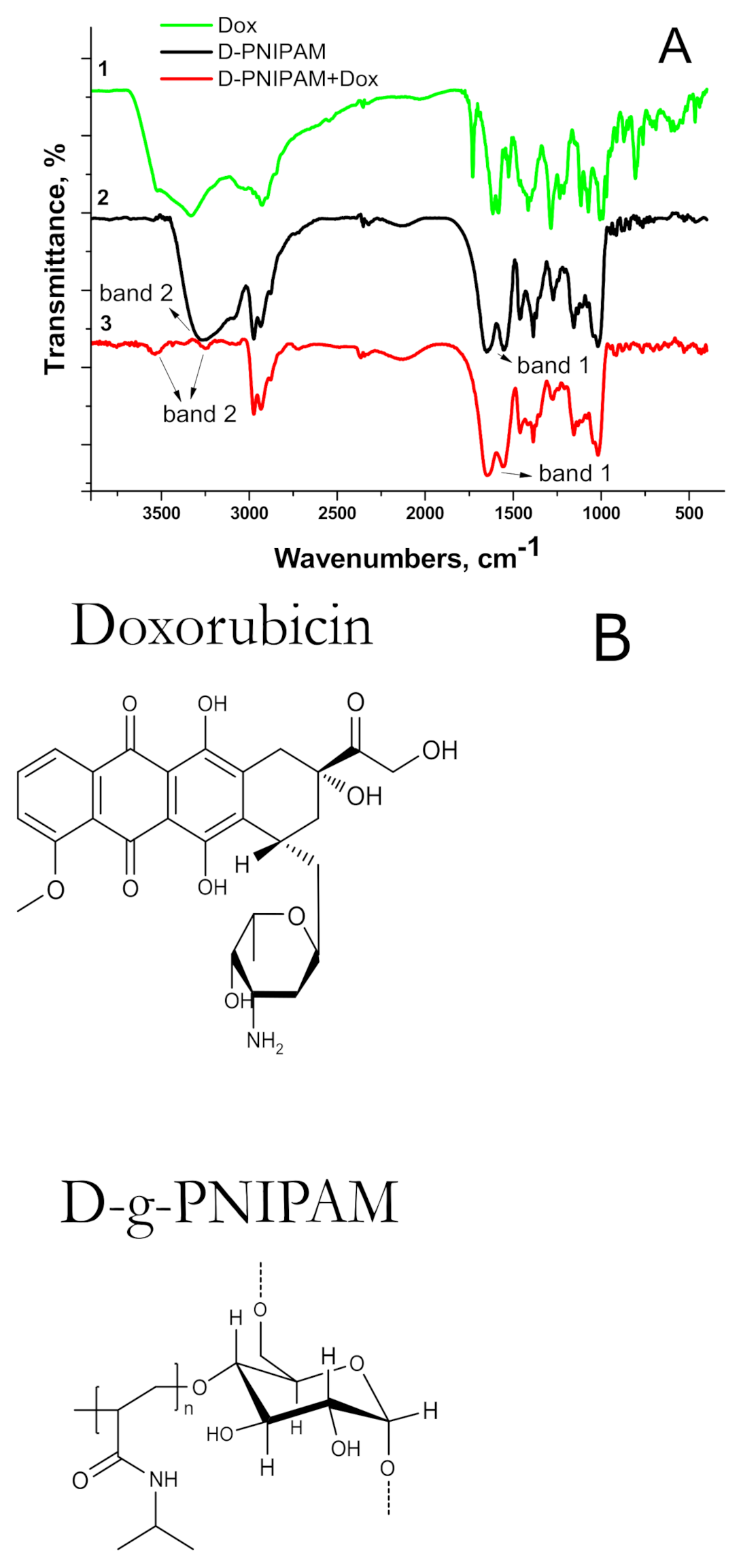
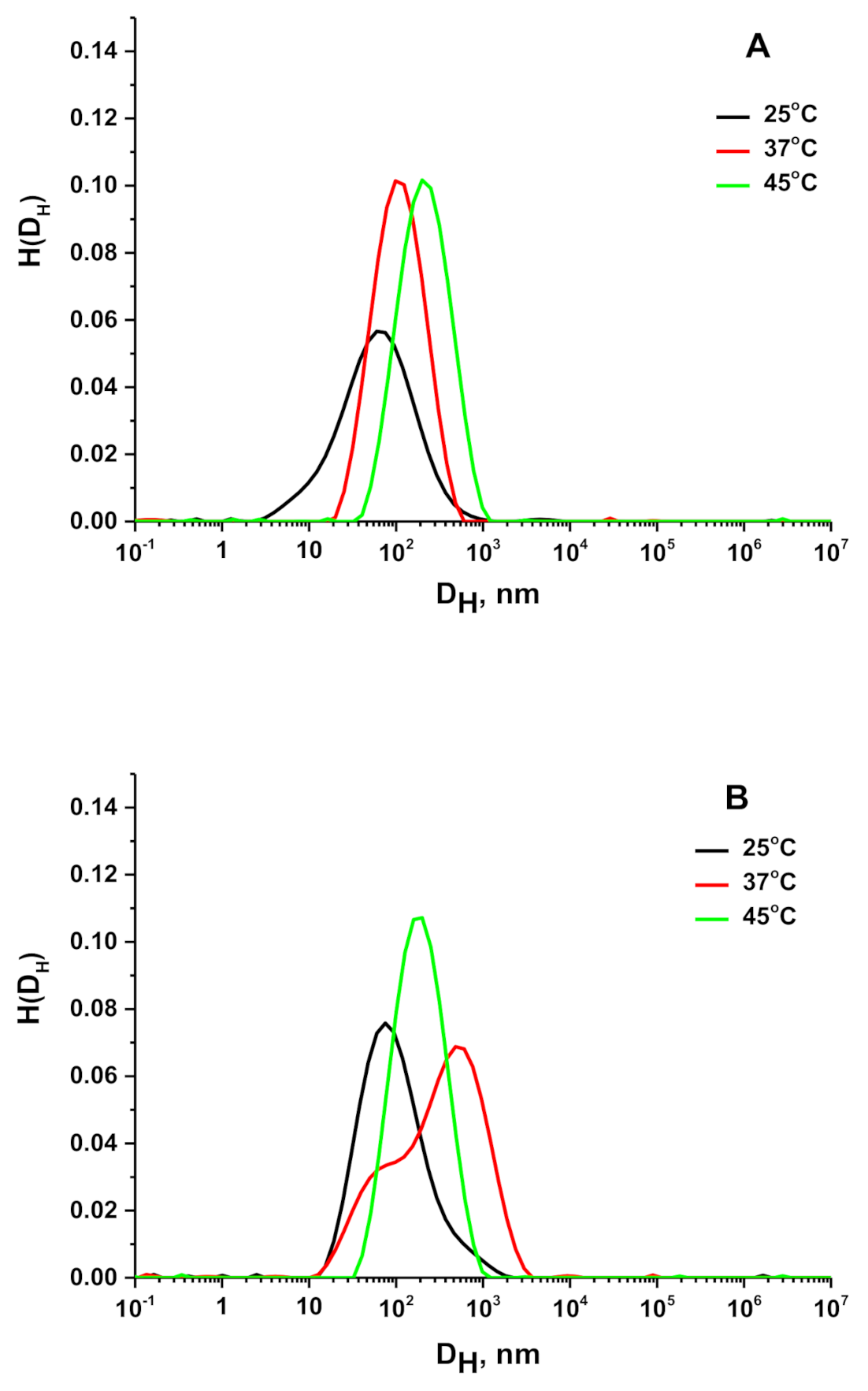
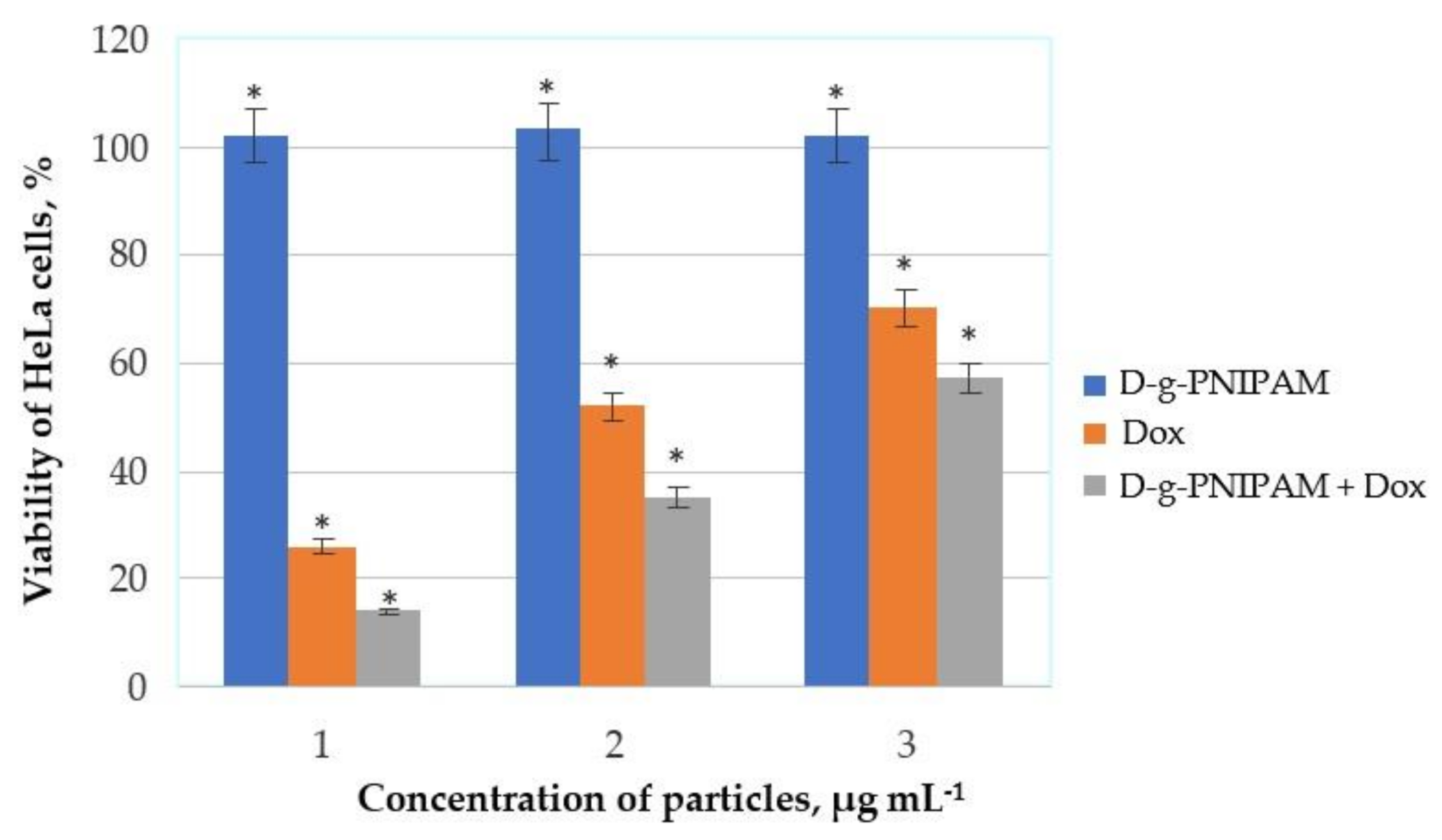
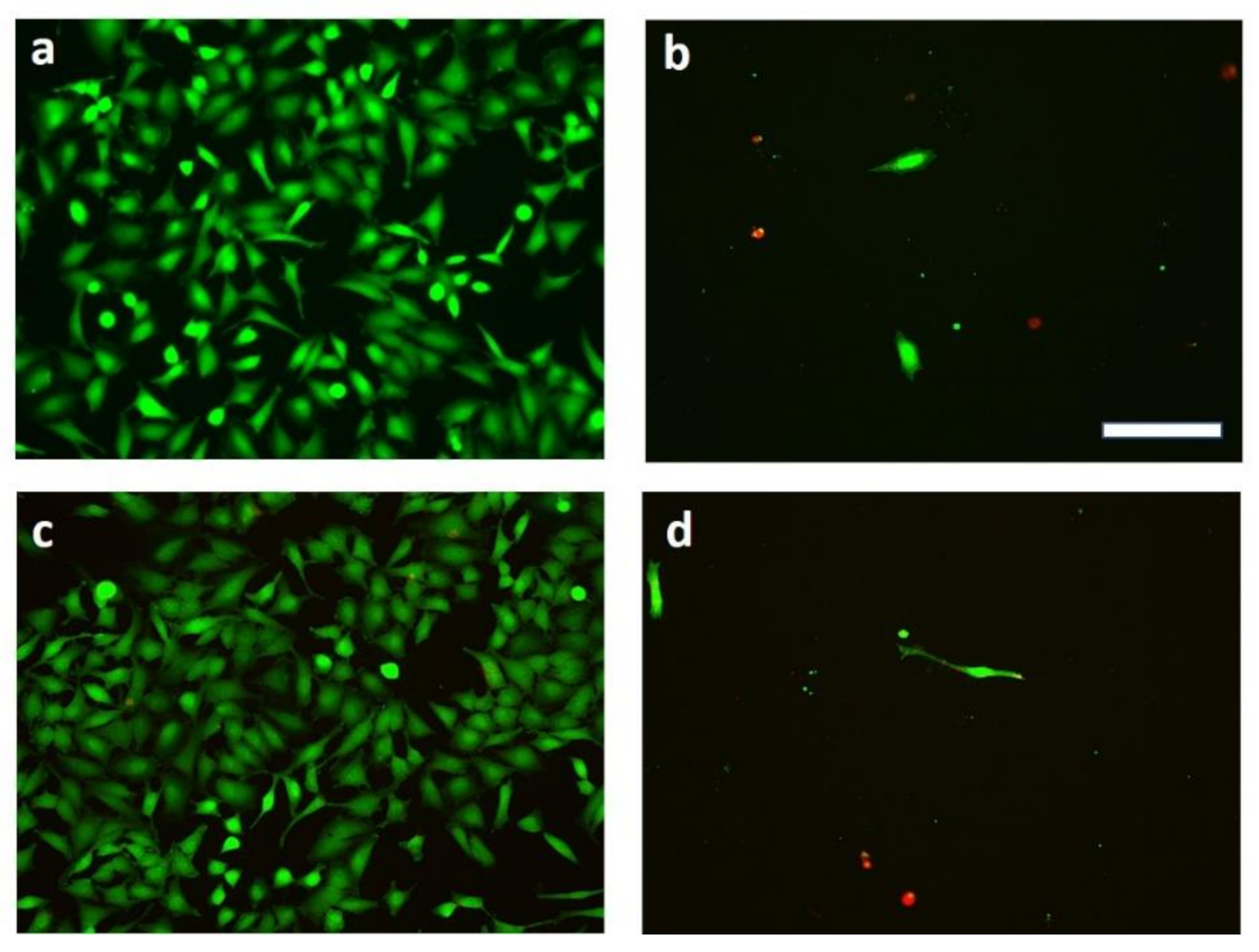
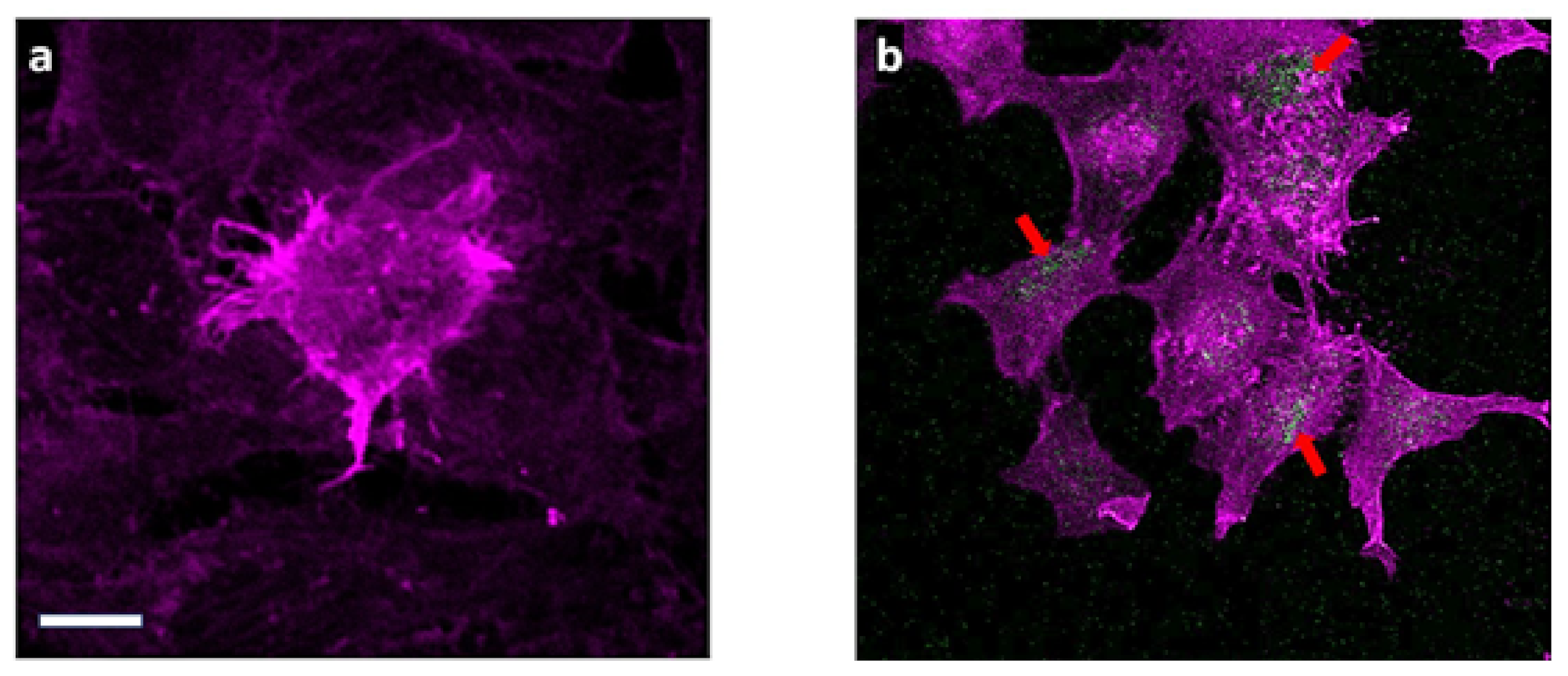
| Sample | Mw × 10−6, g mol−1 | Mn × 10−6, g mol−1 | Mw/Mn |
|---|---|---|---|
| D-g-PNIPAM | 1.03 | 0.674 | 1.52 |
| System | DH (25 °C), nm | PDI (25 °C) | DH (37 °C), nm | PDI (37 °C) | DH (45 °C), nm | PDI (45 °C) |
|---|---|---|---|---|---|---|
| D-g-PNIPAM (125 µg mL−1) | 60 | 0.75 | 110 | 0.52 | 220 | 0.56 |
| D-g-PNIPAM + Dox (125 + 5 µg mL−1) | 76 | 0.62 | 81 (additional peak at 515) | 0.74 | 185 | 0.54 |
Publisher’s Note: MDPI stays neutral with regard to jurisdictional claims in published maps and institutional affiliations. |
© 2021 by the authors. Licensee MDPI, Basel, Switzerland. This article is an open access article distributed under the terms and conditions of the Creative Commons Attribution (CC BY) license (https://creativecommons.org/licenses/by/4.0/).
Share and Cite
Chernykh, M.; Zavalny, D.; Sokolova, V.; Ponomarenko, S.; Prylutska, S.; Kuziv, Y.; Chumachenko, V.; Marynin, A.; Kutsevol, N.; Epple, M.; et al. A New Water-Soluble Thermosensitive Star-Like Copolymer as a Promising Carrier of the Chemotherapeutic Drug Doxorubicin. Materials 2021, 14, 3517. https://doi.org/10.3390/ma14133517
Chernykh M, Zavalny D, Sokolova V, Ponomarenko S, Prylutska S, Kuziv Y, Chumachenko V, Marynin A, Kutsevol N, Epple M, et al. A New Water-Soluble Thermosensitive Star-Like Copolymer as a Promising Carrier of the Chemotherapeutic Drug Doxorubicin. Materials. 2021; 14(13):3517. https://doi.org/10.3390/ma14133517
Chicago/Turabian StyleChernykh, Mariia, Dmytro Zavalny, Viktoriya Sokolova, Stanislav Ponomarenko, Svitlana Prylutska, Yuliia Kuziv, Vasyl Chumachenko, Andrii Marynin, Nataliya Kutsevol, Matthias Epple, and et al. 2021. "A New Water-Soluble Thermosensitive Star-Like Copolymer as a Promising Carrier of the Chemotherapeutic Drug Doxorubicin" Materials 14, no. 13: 3517. https://doi.org/10.3390/ma14133517







